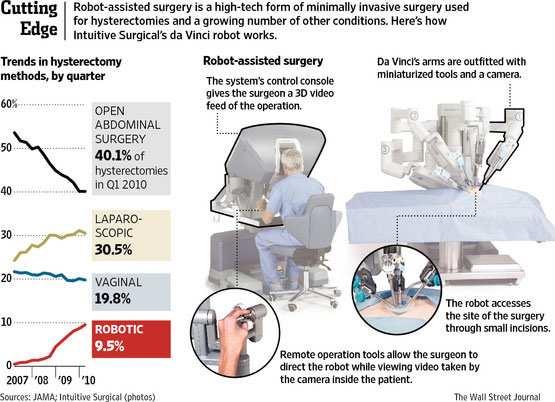| Feb 21, 2013 |
New study questions benefits of robotic surgery
|
|
(Nanowerk News) A report published in the Journal of the American Medical Association ("Robotically Assisted vs Laparoscopic Hysterectomy Among Women With Benign Gynecologic Disease"; free access) raises doubts as to whether robotic surgery provides any greater benefits to patients than conventional laparoscopic surgery: Between 2007 and 2010, the use of robotically assisted hysterectomy for benign gynecologic disorders increased substantially. Robotically assisted and laparoscopic hysterectomy had similar morbidity profiles, but the use of robotic technology resulted in substantially more costs.
|
|
Although robotically assisted hysterectomy for benign gynecologic conditions has been reported, little is known about the incorporation of the procedure into practice, its complication profile, or its costs compared with other routes of hysterectomy.
|
|
The study shows that the use of robotically assisted hysterectomy increased from 0.5% in 2007 to 9.5% of all hysterectomies in 2010. During the same time period, laparoscopic hysterectomy rates increased from 24.3% to 30.5%.
|
|
Total costs associated with robotically assisted hysterectomy on average were $2189 more per case than for laparoscopic hysterectomy.
|
|
In a robotically assisted surgery, the surgeon sits at a console and operates mechanical arms that insert miniaturized tools through small openings in the patient’s body. The physician is guided by a tiny lighted camera that displays the patient’s organs on a 3-D screen.
|
 |
|
According to a report in the Wall Street Journal, advocates of robotic surgery say that the machines, called da Vinci Surgical Systems, and manufactured solely by Intuitive Surgical, Inc., provide patient outcomes that include less scarring, less pain and blood loss, fewer complications and shorter hospital stays than traditional surgery, which involves larger incisions and takes longer to heal.
|
|
Critics say that the same could be said for all minimally invasive procedures. The crucial variable in the studies cited by robotic surgery proponents, they maintain, is that the surgeries were laparoscopic surgeries, not that they were performed by da Vinci machines, which are now being used in prostate surgery, gallbladder and gynecological surgeries.
|
|
The study’s lead author, associate professor of women’s health at Columbia, Jason Wright, told the WSJ, “There are so many options for hysterectomies now that patients should discuss the pros and cons of all of them with their doctors.”
|
|
Myriam Curet, an Intuitive Surgical representative said, “We did not develop the robot to compete with laparoscopic surgery. We developed the robot to bring the benefits of minimally invasive surgery to more women.”
|

